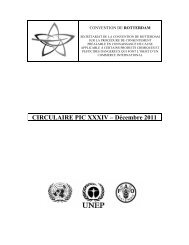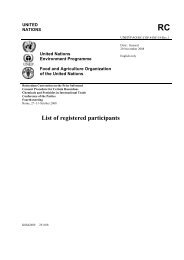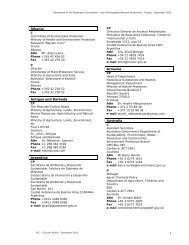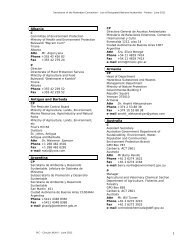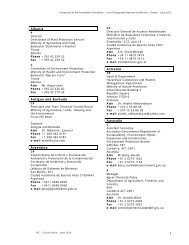RC - What is RC? - Rotterdam Convention
RC - What is RC? - Rotterdam Convention
RC - What is RC? - Rotterdam Convention
Create successful ePaper yourself
Turn your PDF publications into a flip-book with our unique Google optimized e-Paper software.
has<br />
butadiene<br />
GSH reduced glutathione<br />
HCBD hexachlorobutadiene<br />
ip intraperitoneal<br />
iv intravenous<br />
MTPB 1-methylthio-1,2,3,4,4-pentachloro-1,3-butadiene<br />
NIOSH National Institute of Occupational Safety and Health<br />
NOAEL no-observed-adverse-effect level<br />
OECD Organ<strong>is</strong>ation for Economic Co-operation and Development<br />
PATPB 1-(pyruvic acid thiol)-1,2,3,4,4-pentachloro-1,3-<br />
butadiene<br />
PBSA 1,2,3,4,4-pentachloro-1,3-butadienyl sulfenic acid<br />
TBA 2,3,4,4-tetrachloro-1,3-butenoic acid<br />
TPA 12- o-tetradecanoylphorbol-13-acetate<br />
TPB 1-thiol-1,2,3,4,4-pentachloro-1,3-butadiene<br />
UDS unscheduled DNA synthes<strong>is</strong><br />
1. SUMMARY<br />
1.1 Identity, physical and chemical properties, analytical methods<br />
Hexachlorobutadiene <strong>is</strong> a non-flammable, incombustible, clear,<br />
oily and colourless liquid at ordinary temperature and pressure. It<br />
<strong>is</strong> poorly soluble in water but m<strong>is</strong>cible with ether and ethanol.<br />
The substance can be detected and determined quantitatively by<br />
gas chromatographic methods. The detection limits are 0.03 µg/m 3<br />
in air, 0.001 µg/litre in water, 0.7 µg/kg wet weight in soil or<br />
sediment, and 0.02 µg/litre in blood. A level of 0.47 µg/kg wet<br />
weight has been determined in t<strong>is</strong>sue.<br />
1.2 Sources of human and environmental exposure<br />
Hexachlorobutadiene <strong>is</strong> not reported to occur as a natural<br />
product. It <strong>is</strong> chiefly produced as a by-product of the manufacture<br />
of chlorinated hydrocarbons where it occurs in the heavy fractions<br />
(Hex-waste). The world annual production of the compound in heavy<br />
fractions was estimated in 1982 to be 10 000 tonnes.<br />
Hexachlorobutadiene can be used for recovery of<br />
chlorine-containing gas in chlorine plants and as a wash liquor for<br />
removing certain volatile organic compounds from gas streams. It



